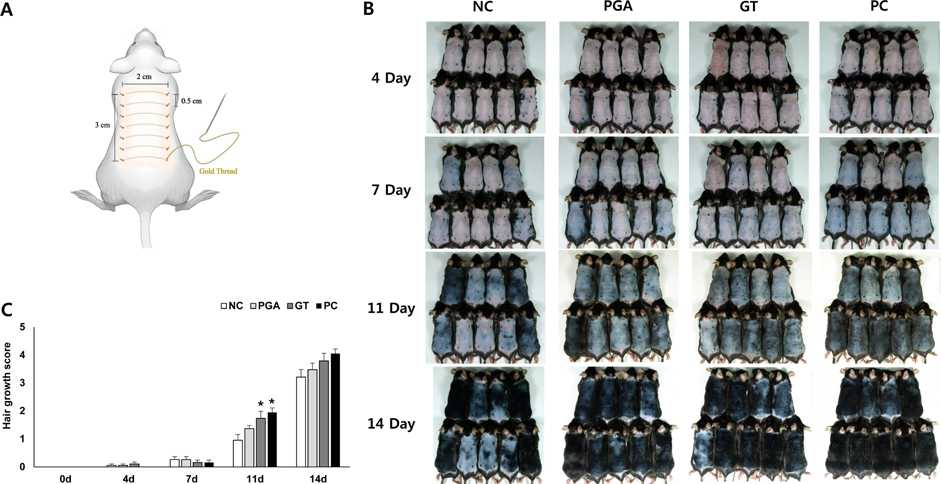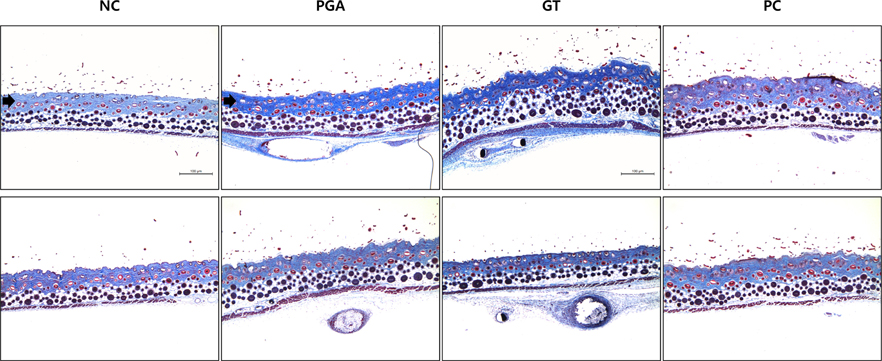Lab Anim Res.
2017 Dec;33(4):291-297. 10.5625/lar.2017.33.4.291.
Gold thread implantation promotes hair growth in human and mice
- Affiliations
-
- 1Goldhappy Mirae Aesthetic Clinic, Seoul, Korea.
- 2Department of Experimental Animal Research, Biomedical Research Institute, Seoul National University Hospital, Seoul, Korea. bckang@snu.ac.kr
- 3Department of Pathology, Seoul National University College of Medicine, Seoul, Korea.
- 4Department of Neurogenetics, Kolling Institute, Royal North Shore Hospital and University of Sydney, St. Leonards, Australia.
- 5Department of Veterinary Public Health, College of Veterinary Medicine, Seoul National University, Seoul, Korea.
- 6Department of Biotechnology, The Catholic University of Korea, Bucheon, Korea. jwyun@catholic.ac.kr
- 7Graduate School of Translational Medicine, Seoul National University College of Medicine, Seoul, Korea.
- 8Biomedical Center for Animal Resource and Development, Seoul National University College of Medicine, Seoul, Korea.
- 9Designed Animal and Transplantation Research Institute, Institute of GreenBio Science Technology, Seoul National University, Pyeongchang-gun, Korea.
- KMID: 2402265
- DOI: http://doi.org/10.5625/lar.2017.33.4.291
Abstract
- Thread-embedding therapy has been widely applied for cosmetic purposes such as wrinkle reduction and skin tightening. Particularly, gold thread was reported to support connective tissue regeneration, but, its role in hair biology remains largely unknown due to lack of investigation. When we implanted gold thread and Happy Liftâ„¢ in human patient for facial lifting, we unexpectedly found an increase of hair regrowth in spite of no use of hair growth medications. When embedded into the depilated dorsal skin of mice, gold thread or polyglycolic acid (PGA) thread, similarly to 5% minoxidil, significantly increased the number of hair follicles on day 14 after implantation. And, hair re-growth promotion in the gold threadimplanted mice were significantly higher than that in PGA thread group on day 11 after depilation. In particular, the skin tissue of gold thread-implanted mice showed stronger PCNA staining and higher collagen density compared with control mice. These results indicate that gold thread implantation can be an effective way to promote hair re-growth although further confirmatory study is needed for more information on therapeutic mechanisms and long-term safety.
Keyword
MeSH Terms
Figure
Cited by 1 articles
-
CRISPR/Cas9-mediated generation of a
Plac8 knockout mouse model
HyunJeong Lee, Joo-Il Kim, Jin-Sung Park, Jae-il Roh, Jaehoon Lee, Byeong-Cheol Kang, Han-Woong Lee
Lab Anim Res. 2018;34(4):279-287. doi: 10.5625/lar.2018.34.4.279.
Reference
-
1. Park TH, Seo SW, Kim JK, Chang CH. The efficacy of perilesional surgical approach for foreign body granuloma. Plast Reconstr Surg. 2011; 127(6):121e–123e.2. Lee KS, Ko MK, Lee JH, Kim MJ, Hong KE. The effect of facial embedding therapy on skin elasticity and moisture content. Acupunct. 2011; 28:111–119.3. Lee SM, Lee CW, Jeon JH, Kim YI. The effect of needle-embedding therapy on the improvement against facial wrinkles: a case series. J Korean Acupunct Moxib Soc. 2011; 28:143–147.4. Li H, Tang CZ, Li SH, Zhang Z, Chen SJ, Zhang JW. Effects of thread embedding therapy on nucleotides and gastrointestinal hormones in the patient of chronic gastritis. Zhongguo Zhen Jiu. 2005; 25(5):301–303.5. Lin ZW, Pan WQ. Investigation on the rate of bone fracture of primary osteoporosis treated by embedding thread at Shenshu (BL 23) during five years. Zhongguo Zhen Jiu. 2010; 30(4):282–284.6. Yao L, Yang Pl, Song WB. Observation on the clinical efficacy of acupoint thread-embedding therapy for chronic bronchial asthma in the persistent phase. Shanghai Med Pharm J. 2011; 32:137–140.7. Li Z, Li WX. Acupoint catgut-embedding for 78 cases of allergic rhinitis. Zhongguo Zhen Jiu. 2013; 33(3):211–212.8. Shin HJ, Lee DJ, Kwon K, Seo HS, Jeong HS, Lee JY, Ha KT, Lee CH, Jang YS, Lee BW, Kim BJ, Jung MH. The success of thread-embedding therapy in generating hair re-growth in mice points to its possibly having a similar effect in humans. J Pharmacopuncture. 2015; 18(4):20–25.9. Paik JH, Yoon JB, Sim WY, Kim BS, Kim NI. The prevalence and types of androgenetic alopecia in Korean men and women. Br J Dermatol. 2001; 145(1):95–99.10. Kerscher M, Williams S, Dubertret L. Cosmetic dermatology and skin care. Eur J Dermatol. 2007; 17(2):180–182.11. So HR, We SY, Im EJ. Comparison of hair loss factors by sex in Seoul and Chungcheon area -Comparison of hair loss factors by sex. J Korean Soc Cosmetol. 2011; 17:286–296.12. Kwon TR, Oh CT, Park HM, Han HJ, Ji HJ, Kim BJ. Potential synergistic effects of human placental extract and minoxidil on hair growth-promoting activity in C57BL/6J mice. Clin Exp Dermatol. 2015; 40(6):672–681.13. Mulinari-Brenner F, Bergfeld WF. Hair loss: an overview. Dermatol Nurs. 2001; 13(4):269–272. 277–278.14. Price VH. Treatment of hair loss. N Engl J Med. 1999; 341(13):964–973.15. Kaufman KD, Olsen EA, Whiting D, Savin R, DeVillez R, Bergfeld W, Price VH, Van Neste D, Roberts JL, Hordinsky M, Shapiro J, Binkowitz B, Gormley GJ. Finasteride Male Pattern Hair Loss Study Group. Finasteride in the treatment of men with androgenetic alopecia. J Am Acad Dermatol. 1998; 39(4 Pt 1):578–589.16. Georgala S, Befon A, Maniatopoulou E, Georgala C. Topical use of minoxidil in children and systemic side effects. Dermatology. 2007; 214(1):101–102.17. Rogers NE, Avram MR. Medical treatments for male and female pattern hair loss. J Am Acad Dermatol. 2008; 59(4):547–566.18. Irwig MS. Depressive symptoms and suicidal thoughts among former users of finasteride with persistent sexual side effects. J Clin Psychiatry. 2012; 73(9):1220–1223.19. Irwig MS. Persistent sexual side effects of finasteride: could they be permanent? J Sex Med. 2012; 9(11):2927–2932.20. Müller-Röver S, Handjiski B, van der Veen C, Eichmüller S, Foitzik K, McKay IA, Stenn KS, Paus R. A comprehensive guide for the accurate classification of murine hair follicles in distinct hair cycle stages. J Invest Dermatol. 2001; 117(1):3–15.21. NRC. Guide for the Care and Use of Laboratory Animals. 8th ed. Washington: National Academies Press;2010.22. Juríková M, Danihel Ľ, Polák Š, Varga I. Ki67, PCNA, and MCM proteins: Markers of proliferation in the diagnosis of breast cancer. Acta Histochem. 2016; 118(5):544–552.23. Barton FE. Facial rejuvenation techniques. Mund Kiefer Gesichtschir. 1997; 1(6):328–334.24. Fagien S. Botox for the treatment of dynamic and hyperkinetic facial lines and furrows: adjunctive use in facial aesthetic surgery. Plast Reconstr Surg. 1999; 103(2):701–713.25. Fagien S, Carruthers JD. A comprehensive review of patient-reported satisfaction with botulinum toxin type a for aesthetic procedures. Plast Reconstr Surg. 2008; 122(6):1915–1925.26. Rondo Júnior W, Vidarte G, Michalany N. Histologic study of the skin with gold thread implantation. Plast Reconstr Surg. 1996; 97(1):256–258.27. Shin KC, Bae TH, Kim WS, Kim HK. Usefulness of Gold Thread Implantation for Crow's Feet. Arch Plast Surg. 2012; 39(1):42–45.28. Yoon JI, Al-Reza SM, Kang SC. Hair growth promoting effect of Zizyphus jujuba essential oil. Food Chem Toxicol. 2010; 48(5):1350–1354.29. Zhang Y, Han L, Chen SS, Guan J, Qu FZ, Zhao YQ. Hair growth promoting activity of cedrol isolated from the leaves of Platycladus orientalis. Biomed Pharmacother. 2016; 83:641–647.30. Hendrix S, Handjiski B, Peters EM, Paus R. A guide to assessing damage response pathways of the hair follicle: lessons from cyclophosphamide-induced alopecia in mice. J Invest Dermatol. 2005; 125(1):42–51.31. Kamiya T, Shirai A, Kawashima S, Sato S, Tamaoki T. Hair follicle elongation in organ culture of skin from newborn and adult mice. J Dermatol Sci. 1998; 17(1):54–60.32. Danilenko DM, Ring BD, Pierce GF. Growth factors and cytokines in hair follicle development and cycling: recent insights from animal models and the potentials for clinical therapy. Mol Med Today. 1996; 2(11):460–467.33. Greco V, Chen T, Rendl M, Schober M, Pasolli HA, Stokes N, Dela Cruz-Racelis J, Fuchs E. A two-step mechanism for stem cell activation during hair regeneration. Cell Stem Cell. 2009; 4(2):155–169.34. Yang CC, Cotsarelis G. Review of hair follicle dermal cells. J Dermatol Sci. 2010; 57(1):2–11.35. Ustuner ET. Baldness may be caused by the weight of the scalp: gravity as a proposed mechanism for hair loss. Med Hypotheses. 2008; 71(4):505–514.36. Rossi A, Cantisani C, Melis L, Iorio A, Scali E, Calvieri S. Minoxidil use in dermatology, side effects and recent patents. Recent Pat Inflamm Allergy Drug Discov. 2012; 6(2):130–136.
- Full Text Links
- Actions
-
Cited
- CITED
-
- Close
- Share
- Similar articles
-
- Pigmentation after Gold Thread Implantation by Illegal Cosmetic Procedure
- Novel Effect of Hyaluronan and Proteoglycan Link Protein 1 (HAPLN1) on Hair Follicle Cells Proliferation and Hair Growth
- Macular Pigmentation Following Low Fluence Nd:YAG Laser Procedure at Sites of Gold Thread Implantation
- An Adverse Effect Following Facial Hair Removal by Thread Shaving
- Usefulness of Gold Thread Implantation for Crow's Feet





